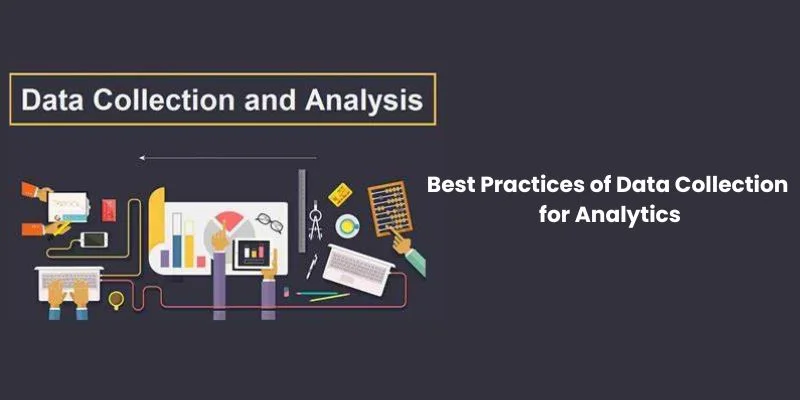
In the realm of data analytics, the quality and integrity of your data collection process can make or break the success of your analysis. Effective data collection lays the foundation for accurate insights and informed decision-making. In this blog, we’ll delve into what data collection entails, explore seven best practices for collecting data for analytics, and discuss how to improve your Data Collection process.
What is Data Collection?
Data collection is the process of gathering information from various sources, such as databases, websites, surveys, sensors, and more. This raw data serves as the basis for analysis, enabling organizations to derive insights, identify patterns, and make informed decisions. The quality, relevance, and completeness of the data collected are critical factors that impact the accuracy and reliability of subsequent analysis. Data Collection can be clearly learned in leading colleges for MBA in Data Analytics.
Best Practices of Data Collection
Given below are some best practices for Data Collection.
Define Clear Objectives
Before collecting any data, clearly define your objectives and what insights you hope to gain from the analysis. Having a clear understanding of your goals will assist the data collection process & ensure that you gather relevant and meaningful data.
Identify Key Metrics
Determine the key performance indicators or metrics that are most relevant to your objectives. Focus on collecting data that directly aligns with these metrics to avoid unnecessary noise and ensure that your analysis is focused and actionable.
Ensure Data Quality
Quality is paramount when it comes to data collection. Ensure that the data you collect is accurate, complete, and consistent. Implement data validation checks and regularly audit your data collection processes to identify & rectify any issues or discrepancies. This is one of the best Data Collection practices.
Maintain Data Security and Privacy
Your efforts to collect data should prioritize data security and privacy. Put strong security measures in place to guard against breaches and unwanted access to sensitive data. Respect privacy laws like the CCPA and GDPR to guarantee that data gathering procedures are morally and legally sound. Importance of Data Security and Privacy can be learned in prominent colleges for MBA in Data Analytics in Chennai.
Use Reliable Data Sources
Choose reliable and reputable data sources for your data collection efforts. Whether it’s internal databases, third-party vendors, or public datasets, ensure that the data you collect is trustworthy and accurate. Verify the credibility and reliability of data sources before incorporating them into your analysis. This is one of the Data Collection best practices.
Standardize Data Formats
Standardizing data formats and structures ensures consistency and compatibility across different datasets. Adopting common data standards and conventions makes it easier to integrate & analyze data from multiple sources, leading to more robust and comprehensive insights.
Document Data Collection Processes
Documenting your data collection processes is essential for transparency, reproducibility, and auditability. Keep detailed records of data sources, collection methods, data transformations, and any modifications made to the data. This documentation serves as a reference for future analysis and helps maintain data integrity over time. Several Top MBA Colleges Near Me offer Data Analytics courses.
How to Improve Data Collection?
Continuous improvement is key to optimizing your data collection process. Here are some tips for how to improve Data Collection:
Automate Data Collection
Leverage automation tools & technologies to streamline and automate data collection processes. Automation reduces manual effort, minimizes errors, and ensures data consistency and reliability.
Invest in Data Quality Tools
Invest in software and tools for data quality that can assist in detecting and resolving problems with data quality in advance. To increase your data’s correctness and completeness, these technologies may validate, clean, and enrich it.
Monitor Data Collection Performance
Regularly monitor the performance of your data collection processes to identify bottlenecks, errors, or inefficiencies. Use monitoring tools and metrics to track data collection success rates, processing times, and data quality metrics. This is one of the best tips for how to improve Data Collection.
Collect Feedback and Iterate
Solicit feedback from stakeholders and data users to identify areas for improvement in your data collection processes. Use this feedback to iterate and refine your data collection strategies, ensuring that they align with evolving business needs and objectives.
Stay Updated with Best Practices
Keep up with the latest developments in data collecting and analytics technology, trends, and industry best practices. Continuous learning and knowledge sharing ensure that your data collection processes remain current, efficient, and effective.
Collaborate Across Teams
Foster collaboration and communication across different teams involved in data collection, analysis, and decision-making. Align on common objectives, share insights and learnings, and leverage collective expertise to optimize data collection efforts and drive business outcomes.
Regularly Review and Audit
To find opportunities for improvement and make sure that your data gathering procedures are in compliance with both internal and external regulations, conduct routine reviews and audits. To ensure the integrity and reliability of your data, look for ways to improve its quality, security, and privacy.
Effective data collection is essential for deriving actionable insights and driving informed decision-making in data analytics. By following best practices such as defining clear objectives, ensuring data quality, and maintaining security and privacy, organizations can optimize their data collection processes and unlock the full potential of their data assets. To learn more about the Best Practices for Data Collection enroll in MBA Colleges in Chennai. Continuous improvement, collaboration, and adherence to best practices are key for constructing a robust and reliable data collection framework that supports business objectives and drives success in the digital age.
